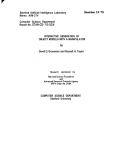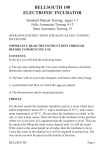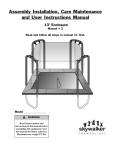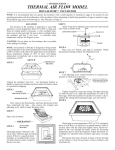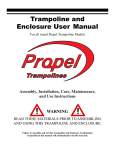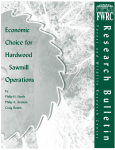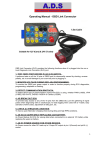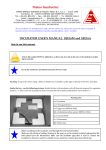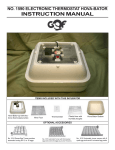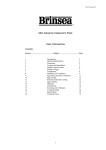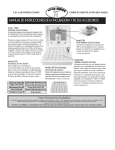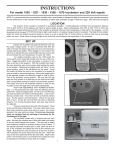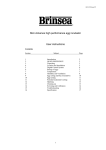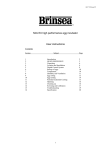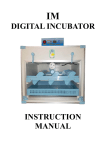Download INCUBATOR & ACCESSORY INSTRUCTION MANUAL
Transcript
THOROUGHLY BEFORE USE READ INSTRUCTIONS INCUBATOR & ACCESSORY INSTRUCTION MANUAL Model 10200 Circulated Air Incubator Features fully-installed Circulated Air Fan Kit to help keep temperature uniform inside the incubator. Features two 4” x 8” viewing windows. Comes complete with thermometer, solid state thermostat, and built-in moisture rings in the base of the incubator. Approximate capacity without automatic egg turner is 46 chicken eggs, 118 quail eggs, 90 pheasant eggs, 40 turkey or duck eggs. Follow the same operating instructions as the Model 9200 except where noted. Model 7200 Circulated Air Fan Kit Converts the Model 9200 Still Air Incubator to a circulated air incubator. Helps improve hatch conditions by circulating a constant flow of warm air. (sold separately) Model 9200 Still Air Incubator Model 6300 Automatic Egg Turner Features two 4” x 8” viewing windows. Comes complete with thermometer, solid state thermostat, and built-in moisture rings in the base of the incubator. Approximate capacity without automatic egg turner is 46 chicken eggs, 118 quail eggs, 90 pheasant eggs, 40 turkey or duck eggs. 10200 Circulated Air Incubator 9200 Still Air Incubator 6300 Automatic Egg Turner 7200 Circulated Air Fan Kit 6302 Quail Rails Kit For chicken, quail, pheasant, turkey, and duck eggs For chicken, quail, pheasant, turkey, and duck eggs For chicken, quail and pheasant eggs For chicken, quail, pheasant, turkey, and duck eggs For quail and and other small eggs Features motorized egg turner with six large egg racks holding up to seven eggs each. Safely turns eggs to prevent the yoke from settling to one side and to exercise the embryo. This eliminates turning the eggs by hand which is the most demanding and time consuming part of egg incubation. Fits models 9200 and 10200 Incubators. Turkey and duck eggs will not fit in the Automatic Egg Turner. (sold separately) Model 6302 Quail Egg Trays Kit Replaces standard egg rails with rails specifically designed to hold up to 120 quail or other small eggs. (sold separately) How An Incubator Works The function of an incubator is to bring normal room temperature up to a desired temperature for hatching eggs. If your room temperature is constant and free of drafts, your Little Giant incubator will need very few adjustments once regulated. If your room temperature fluctuates more than a few degrees your incubator will need periodic adjustments. Be sure to monitor your incubator regularly. Consult with your library, local hatchery, or the internet for hatching guidelines specific to the type of eggs you plan to incubate. WARNING • This product must be used with a Ground Fault Circuit Interrupter (GFCI) protected outlet. • DO NOT connect the product to an outlet with extension cords. • DO NOT expose the product’s electrical parts to water. How to Use Your Little Giant Incubator & Accessories Note: Due to different hatching requirements, it is recommended that you hatch only one species of egg per hatch. For example, it is not recommended that you attempt to hatch chicken and quail eggs at the same time in the same incubator. Please refer to your local library or the World Wide Web for additional hatching information. Step 1: Choosing The Proper Location For Your Incubator Install your incubator in a room that has a stable temperature. Avoid setting your incubator in drafty areas like near a window or on a porch. Avoid direct sunlight. The ideal room temperature is 70°F. The model 10200 Circulated Air Incubator and the model 9200 Still Air Incubator outfitted with a Circulated Air Fan Kit (sold separately) can operate in room temperatures between 60°F- 80°F. The Still Air Incubator without a Circulated Air Fan Kit can operate in a room temperatures between 65°F and 72°F. 6200 Cord Exit Slot 6300 Cord Exit Slot Step 2: Installation and Set Up Unpack your incubator. The top half should be complete with windows, element, thermostat, indicator light, and power cord. Place the wire screen in the incubator bottom. Line up the cord exit slot in the top half with the slot in the bottom half. This notch is used for the power cord when using the Automatic Egg Turner. The model 6300 Automatic Egg Turner is sold separately and fits either incubator. Six Large Egg Trays are included with the Automatic Egg Turner. The Automatic Egg Turner makes one complete cycle (30 degrees side to side) every 4 hours. IMPORTANT: DO NOT MOVE THE EGG TRAYS BY HAND. The egg turner moves very slowly. It takes (4 hours to complete a 30 degree side to side cycle. This movement may not be detected by the naked eye. Unpack the Automatic Egg Turner from the box; holding it over the incubator, line up the power cord exiting the motor with the side of the incubator bottom that has a notch molded in it. Place the automatic egg turner in the incubator so it fits flat on all four corners over the wire mesh floor. Plug the cord into a surge protector. Plug the surge protector into a 110 volt GFCI protected outlet. On 240/400 volt model, attach plug required by country standards. Please calibrate the thermometer with one known to be accurate. Screen IMPORTANT: If you have a model 9200 or Figure A 10200 incubator without a model 6300 power cord exit slot (see Figure A) you must add one. Use a screw driver or similar shaped object, lay it across the edge of the incubator and press down to form a slot in the location shown. Install Circulated Air Fan Kit if purchased separately (see separate instructions included with Fan Kit). The Circulated Air Fan Kit converts the model 9200 Still Air Incubator to a Circulated Air Incubator. The fan kit helps keep the temperature uniform throughout the incubator. The fan circulates the air. It does not regulate the temperature. Step 3:Incubator Regulation Before beginning a hatch, you need to regulate the incubator temperature. Turn the control knob fully clockwise. The red indicator light will come on and the element will begin to heat. Watch the thermometer as the incubator heats up. As soon as it registers to the temperature recommended for the species you are hatching, turn the control knob slowly. Adjust the control knob counter clockwise to decrease heat and clockwise to increase heat until you have it regulated to hold at the desired temperature. The red indicator light may flicker off and on during this process. This is normal and indicates that the incubator is adjusting to changes in both internal and external air temperatures. Run the incubator for 6-8 hours. At the end of this time, make sure the desired temperature was maintained. If so, you are ready to incubate! Step 4: Humidity Control and Ventilation Fill the moisture rings in the bottom of the incubator with water. Water will help keep eggs naturally moist. Check moisture rings daily, adding lukewarm water as needed. If the room where your incubator is placed has good natural moisture content, add water less frequently than if your climate or room conditions are dry. Good ventilation is important in the hatching process. Air exchange is needed during embryo development and should be increased as chicks start to hatch. Remove one of the red plastic vent plugs on the top of the incubator. One is located between the two windows toward the front of the incubator, closest to the power cord. The second is located at the opposite end of the incubator, furthest from the power cord. If your incubator has a fan kit, evaporation may occur at a more rapid rate. If so, you will need to add water more frequently. Step 5: Maintain Sanitary Conditions aligned with the appropriate slot before setting the top in place and pluging in the Automatic egg turner. You can now view the temperature readings thru the window IMPORTANT: The model 9200 and 10200 incubators were previously supplied with a thermometer that was attached to a metal bracket, you must use the new thermometer supplied with the Automatic Egg Turner. The new thermometer supplied with the Automatic Egg Turner is mounted to a permanent clear plastic holder and is placed flat on top of the eggs. If you do not have an Automatic Egg Turner: Using a lead pencil, lightly place a small "x" on one side of each egg, and an "o" on the other side. (Do not use pen or markers as they may contaminate the eggshell.) This mark will help you identify when eggs have been turned. Consult your local library, local hatchery, or the World Wide Web for information and tips on successful hatching. Embryos are extremely susceptible to disease from bacteria. Hand perspiration or other foreign materials block the pores of the shells and can permeate the egg, resulting in bacterial growth. Always wash hands with anti-bacterial soap before handling eggs. Avoid excess handling of eggs. Avoid breathing on eggs, particularly if you have a cold or are ill. Eggs should be held in a cool location between 50 - 55°F until you are ready to incubate. Do not refrigerate. Step 6: Mark and Set the Eggs If using the Automatic Egg Turner: Set eggs in the turner with the small end down. Do not put goose or other large eggs in the turner. They are too large for the egg cups and may come in contact with the heating element or fall out of the cups. Do not place an egg in the hole closest to the motor. Do not over load the Automatic Egg Turner. You will note that with the Automatic Egg Turner, the eggs sit up higher and are closer to the heating element. Place the Thermometer with the permanently attached plastic holder so that it lays flat on the top of the eggs, to assure the temperature reading is taken at the top of the eggs. Line the notches in the top half of the incubator with the notches in the bottom half; make sure the power cord is Place the eggs in the incubator so that they lay sideways on the wire screen. Do not overcrowd eggs. Place the Thermometer with the permanently attached plastic holder so that it lays flat on the top of the eggs. Warm air rises and the thermometer should be read at the top of the eggs. Set the top of the incubator in place, and if necessary, move the thermometer so you can view the temperature readings thru either window. Allow at least 2-3 hours for the eggs to warm up to the temperature of the incubator. Do not adjust the control knob during this time. Do not open the incubator the first day after the eggs are set. Step 7: Turning The Eggs Turn the eggs at least 2-3x per day, every day at the same time. Avoid shocking and jarring the eggs. Eggs can be rotated by removing a few from the center of the incubator and rolling the rest toward the center. Using the palm of your hand, gently roll the eggs until they have been turned. Continue to turn eggs until 3 days prior to total incubation and hatching time. If using the Automatic Egg Turner, discontinue use 3 days prior to total incubation and hatching time (see Step 9 Hatching Time and Temperature chart). Unplug the turner and remove it from the incubator. Carefully place eggs on the wire screen. Miller Manufacturing Company • 1450 West 13th St. • Glencoe, MN 55336 • Customer Service 800-260-0888 • FAX 952-846-2301www.miller-m fg.com • Fertility Testing White, clear-shelled Eggs Phase 1 Phase 2 Dark-shelled Eggs 3rd or 4th day of incubation 7th or 8th day of incubation 14th day of incubation 14th day of incubation It is critical that you stop turning/rotating eggs 3 days prior to incubation. The chicks are positioning themselves for hatching. Step 8: Test Egg Fertility Fertility testing is done to make sure that embryos are developing properly and to test that humidity conditions are acceptable. Fertility testing should be conducted at two different times: Testing is done by candling all eggs in the incubator. A candler can be made using a shoe box or can. Make a hole with a diameter of about 25% the size of the egg (about the size of a quarter) in the top of the box or can. Set the egg on this hole. Now place a strong light source (a mechanics trouble light or flashlight will do) under the box or can. Light will pass through the hole, into the egg, so that it is illuminated. • If you observe a cloudy spot or mass, then a live, growing embryo is present. • If the contents of the egg allow light to pass through it uniformly, then it can be assumed the egg is not fertile. Remove it from the incubator. Some of the embryos that looked healthy during your first fertility test may have weakened and died by the second fertility test. These eggs and any eggs that show signs of blood spots should be removed from the incubator. Step 9: Hatching Eggs When you have 3 days remaining until hatch, stop turning the eggs. If you have an automatic turner, unplug it, and remove it from the incubator. Carefully place eggs on the wire screen. Remove both red vent plugs from the top of the incubator to increase ventilation. Increase the humidity level (see step 4). This allows the chick to rotate freely while breaking the shell during hatching. Do not open incubator except to remove chicks. Chicks can be removed from the incubator when they are completely dry. Some chicks may hatch late, so continue to run the incubator for a few extra days beyond the normal hatch period. Bird Chicken Bobwhite Quail Cortunix Quail Pheasant Chukar Turkey Duck Goose Guinea *Estimated Days for Hatching 21 23 17-18 23-28 23-24 28 28 28-34 28 Hatching Temperature (°F) 99.5 99.5 99.9 99.5 99.5 99 99.5 99 99.5 *For more information on incubating, consult your local library or the World Wide Web. Step 10: Post Hatch When chicks are removed from the incubator, they must have a place that is warm and dry. Please consult your library, internet, or local hatchery for information on brooding, feeding, and watering. After all chicks have been removed from the incubator, rinse the bottom with anti-bacterial soap. Do not scrub, as this will cause damage to the incubator. The Automatic Egg Turner base and trays can be washed in a dishwasher after the egg turner has been properly disassembled (see below). Lift Motor Washing the Automatic Egg Turner Disassembly: Place complete Automatic Egg Turner on a flat surface. Slide power cord horizontally to remove from notch in base. Loosen two screws connecting the motor to base and remove. Slide motor upward, releasing the white plastic lever from Tbracket of connecting rod. Turn connecting rod so offset arms rest in a horizontal position and egg trays are vertical. Lift offset arm to release connecting rod from notches. Lift individual egg trays by offset arms while still in a horizontal position from offset arm notch in base and pull slightly to release the pin from the corresponding hole in the base. Repeat with all six trays until you are left with an empty base. Remove Cord Remove Screws Rotate Trays Place egg trays and base in dishwasher, run and dry. (continued) Washing the Automatic Egg Turner (continued) shaped end of the connecting rod should align with the motor location. Assembly: Select one of the six egg trays and attach the position cover to the egg tray location nearest the offset arm end by inserting the circular pins on the position cover into the aligning holes on the egg tray (large egg trays only). Once in place, press cover firmly into holes. Attach egg tray with cover to the motor end of the base. The motor location is recognizable by the two holes in the extended plastic end. Holding the egg tray vertical, with the offset arm in a horizontal position, insert the round pin on the end of the tray into the corresponding hole in the base. With the egg tray still vertical, rotate the egg tray downwards so the offset arm end pivot slides into the corresponding notch in the base. Repeat with remaining five egg trays until all six are aligned with the base. Once all egg trays are in the base, keep all egg trays vertical and offset arms in a horizontal position. Bring the connecting rod into position by holding it parallel to the base and slightly above the offset arms. The T- Lower the connecting rod so each egg tray offset arm slips into place into the corresponding notch in the connecting rod. Carefully rotate the six egg trays while holding the offset arms in the notches in the base and connecting rod until all offset arms are in a vertical position and the egg trays are level. Place a flat object on the level egg trays to retain position for motor installation. Slide the white plastic lever on the side reverse of the power cord on the motor down into the T-shaped bracket at the end of the connecting rod. When in place, the two holes at the base of the motor should align directly with the two holes in the projecting plastic of the base. Insert two screws through the frame and tighten into holes in motor flange to secure. Line up the power cord exiting the motor with the side of base that has a notch molded in it. Find the larger groove in power cord and slide into the notch in the base. Troubleshooting Tips For Incubator Use Problem Indicator light not coming On Uncover Is unit plugged in? Is there power to this outlet? Are you using a surge protector? Possible Reasons Erratic power source Indicator light flickering This is normal. The unit is adjusting to temperature changes or variations Loss of power Is unit plugged in? Are you using a surge protector? Erratic power source or loose wire Incubator not heating to 100°F Is room temperature between 65º and 72º? Is the ambient temperature consistent? Is the unit located near any drafts? Room may be too cold or drafty Incubator drying out Did you add water to rings? How much? Add a wet sponge? Room is excessively dry Temperature & humidity are too low during hatch Replace the vent plug(s) The 9200 and 10200 Incubators are intended for general poultry hobbyists and are not recommended for professional or commercial use or for the incubation of exotic birds. MILLER MFG. CO. WARRANTY Miller Mfg. Co. products are warranted to the original purchaser to be free from defects in material and workmanship under normal use and service. Miller’s obligation under this Warranty shall be limited to the repair or exchanges of any part or parts, which may thus prove defective under normal use and service within 30 days from the date of shipment by Miller to the original purchaser, and which Miller examination shall disclose to its satisfaction to be thus defective. Purchaser must deliver any part or parts to Miller Manufacturing Company, 1450 West 13th Street, Glencoe, MN 55336, for examination. DISCLAIMER: DUE TO THE NUMEROUS FACTORS RELATING TO THE HATCHING OF EGGS, MILLER MFG. CO. MAKES NO WARRANTY WHATSOEVER IN RESPECT TO THE NUMBER OF EGGS THAT WILL BE HATCHED USING THE #10200 CIRCULATED AIR INCUBATOR, #9200 STILL AIR INCUBATOR, OR THE #6300 AUTOMATIC EGG TURNER. THIS WARRANTY IS EXPRESSLY IN LIEU OF ALL OTHER WARRANTIES EXPRESS OR IMPLIED INCLUDING THE WARRANTIES OF MERCHANTABILITY AND FITNESS FOR USE AND ALL OTHER OBLIGATIONS OR LIABILITIES ON OUR PART. WE NEITHER ASSUME NOR AUTHORIZE ANY OTHER PERSON TO ASSUME FOR US, ANY OTHER LIABILITY IN CONNECTION WITH THE SALE OF MILLER PRODUCTS OR ANY PART THEREOF WHICH HAS BEEN SUBJECT TO ACCIDENT, NEGLIGENCE, ALTERATION, ABUSE OR MISUSE. WE MAKE NO WARRANTY WHATSOEVER IN RESPECT TO ACCESSORIES OR PARTS NOT SUPPLIED BY US. THE MODEL 9200 AND 10200 INCUBATORS ARE INTENDED FOR GENERAL POULTRY HOBBYISTS AND ARE NOT RECOMMENDED FOR PROFESSIONAL OR COMMERCIAL USE OR FOR THE INCUBATION OF EXOTIC BIRDS. DISCLAIMER: DUE TO THE NUMEROUS FACTORS RELATING TO THE HATCHING OF EGGS, MILLER MFG. CO. MAKES NO WARRANTY WHATSOEVER IN RESPECT TO THE NUMBER OF EGGS THAT WILL BE HATCHED USING THE MODEL 10200 CIRCULATED AIR INCUBATOR, MODEL 9200 STILL AIR INCUBATOR, OR THE MODEL 6300 AUTOMATIC EGG TURNER CONSULT WITH YOUR LIBRARY, LOCAL HATCHERY, OR THE INTERNET FOR HATCHING GUIDELINES SPECIFIC TO THE TYPE OF EGGS YOU PLAN TO INCUBATE. One source for hatching information can be found at: www.msstate.edu/dept/poultry/hatch.htm Miller Manufacturing Company • 1450 West 13th Street • Glencoe, MN 55336 Customer Service 800-260-0888 • FAX 952-846-2301 • www.miller-m fg.com 920006 Rev 5 5/07






